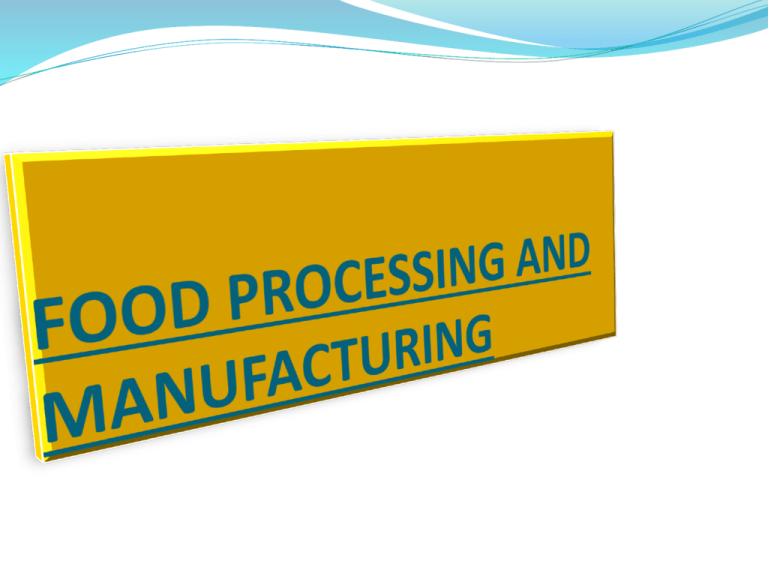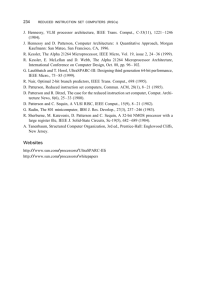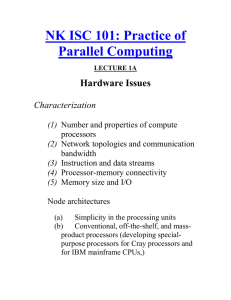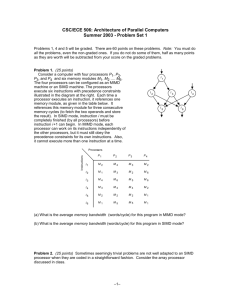Food processing and manufacturing
advertisement

MARKETING MANAGEMENT IN FOOD MANUFACTURING Food processors are quite adept at using all of the 4ps in developing value added products that will improve their competitive positions in the marketplace by better satisfying consumers needs and wants. They practice market segmentation, target marketing, product differentiation, and positioning of their value added, branded products. Positioning refers to the image in the consumers mind that a firms marketing strategy gives to its products their value for customers. Product Strategies The goal of marketing management in food processing is to transform an undifferentiated, low profit commodity into a differentiated, branded, high value added, profitable food product. This is not magic, but neither is it an easy, inexpensive task. The marketing strategies employed by food processors are numerous. They are easily observed by reading any publication with food advertisements or by visiting the grocery store. In their product strategies, food processors attempt incorporate all relevant aspects of the product bundle of attributes into their marketing strategies. Branding is probably the most important product strategy of food processors. A brand is a name, term, symbol, or design that identifies the seller and differentiates the product from those of competitors. Branding permits the food manufacturer to certify the quality of products, transfer the goodwill of the firm to new products, and otherwise differentiate the product from competitors’ offerings. A well known and trusted brand can earn the food processor brand loyalty from customers. Three types of innovations have been important for food manufacturers (1) new marketing methods and techniques which often increase operational efficiency (2) new products or services which add more consumer value to products and (3) new business organizations such as the cooperative food processor, joint ventures between firms, or new market channels. Pricing Strategies Food processors may employ a number of pricing strategies. For example, one processor may use a gourmet strategy, with a high quality high price mix, while another may use a value pricing strategy with a lower price and quality appeal. An important lesson in marketing is that not everyone wants the highest quality product and almost everyone is willing to sacrifice some quality for a lower price. Psychological pricing riders to a situation where a higher price, along with status advertising, encourages consumes to purchase products. Food manufactures also may package a product to a specific price point(e.g.,Tk 499) or use price discounts (Tk – off, 2 for 1 sale) to attract consumers. Place/ Distribution strategies Place or distribution strategies for food processors include selling through conventional food stores, selling foods in nonfood stores, selling to the food service market, mail or catalog selling, home delivery, and even selling foods door to door by high school or scouting organization. While most food manufacturers prefer the sales volume they get from mass outlets, they may also include more selective place strategies in their marketing mix. Again, marketing teaches that there is no one best strategy for reaching consumers, and multiple strategies are often preferred to a single approach. Food processors must also select a sales approach. Larger processors usually have their own sales offices, warehouses, and personal sales force. Smaller firms may sells their products through food brokers. Processors may choose to market their products in many alternative ways. The three principal markets for food processors are industrial customers, foodservice firms, and consumer markets. These may involve local, regional, national, or international sales. Many processors operate their own sales offices and wholesale operations but few are engaged in retailing directly to consumers. The large processors with a relatively full line of product will often operate its own warehouse and wholesaling system. If on the other hand, the line of products is limited, the processor will often have the sales work done by a broker. Industries vary in the directions they have taken. The meat packing industry, for example, has largely become its own wholesaler. It is handling a perishable commodity with wide fluctuations in volume. In order to keep such a product moving effectively, many packers consider it imperative that they have control of the distribution channel to the retailer and operate their own wholesaling establishments. Many dry goods manufacturers, on the other hand, rely own brokers to distribute their products to wholesalers and retailers Promotional Strategies Food manufacturers have many choices to make here in selecting the goal of the promotion,(to remind, inform or persuade); The theme or appeal(price, quality etc.) of the promotion, the type of promotion, (advertisement, sales promotion etc.) which media (print, broadcast, direct mail, point of purchase, etc.) will carry the promotions and who the promotion will be targeted to (the user, the buyer or the influence). The major food processors differentiate their products through mass media advertising, coupons, free samples, cents off deals, promotions trade allowances, and point of purchase merchandising materials. Food processing firms are among the matins leading advertisers, and food products are the most heavily advertised consumer products. Food products lead in expenditures for advertising, discount coupons, contests, and other forms of promotion. Food manufacturers advertising expenditures average about 3 percent of their sales, and in recent years these advertising costs have amounts to 1.5 percent of consumers food. This advertising is important to the competition between food processors for the consumers favor. Food their part, consumers receive from this advertising and promotion some useful and some not so useful information, numerous persuasive messages that may influence their behavior, and perhaps some entertainment. MANAGEMENT PROBLEMS AND FACE CHALLENGES OF FOOD PROCESSORS Food processors experience problems and face challenges in two major areas; processing operations and buying operations. Processing operations Food processing involves significant investments in plant and equipment. In order to operate efficiently, these facilities should be used to full capacity year round, every year. This is difficult to achieve when there are wide variations in farm product supplies front year to year and within seasons. Because of the short harvest season and perishability of many farm products, food processing plants may operate at above capacity rates for a few months of the year and at below capacity rates for the rest of the year. For example, livestock slaughter and processing plants typically operate at close to 90 percent if capacity utilization year round while fruit and vegetable caning plants may average 60 percent capacity for the year. These variations can significantly influence food processing costs. Expanded storages of the product at harvest for later processing, and extension of the processing season by manufacturing no seasonal food items have contributed to the solution to this problem. Processors face a dilemma when deciding on the number and size of plants to build. Replacing a single, large plant with several smaller ones reduces some assembly and transport costs but may require sacrificing the operational efficiencies of larger scale centralized plants. A major thrust of food processors in recent years has been the replacement of human labor with machines and equipment. The continuous increase in labor costs has given added incentives for mechanizing and automating food processing operations. Investment in new plants, equipment, product development, and technologies is important to the progressiveness and productivity of an industry. Food processors spend a relatively small share of their budget for research and development. Buying operations Food processors are major buyers of farm products. The value of farm commodities purchased represents 26% of the food processor sales dollar. The procurement decisions must consider how to handle many of the marketing functions, including storage, transportation, risk bearing, financing, and market intelligence. Because of variations in output and prices of farm products, the buying and pricing decisions of processor affect the division of risk shares between food producers and processors. Food processors have developed elaborate market information financing, and grower programs to better manage their function. assistance The buying power of food processors is generally greater in procurement markets than in their sales markets. Food processors utilize a wide variety of ways to procure their raw product materials from farmers. Most processors do not produce their own raw product supplies but purchase these from farmers. Some purchase directly from producers at the farm, other marketing agencies, another associations for suppliers and prices. bargaining Processor contracting for farm product supplies is an increasing trend for many products. These contracts may contain a wide range of specifications, including the time and method of price determination, the delivery terms, the quality required, and even production practices These processor contracts reallocate risk and financing between the producers and buyers of farm products. Market orientation requires that processors more carefully coordinate their procurement activities with their processing and selling operations. The improved scheduling and coordination of such practices can reduce processors, supply and price risks, contribute to more successful marketing strategies and improve profits.







